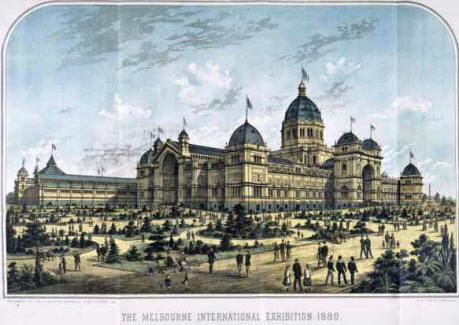Dear Donald,
As always, we welcome your contributions of stories and photos. Enjoy.
| Introduction |
Ray Jerrems, Our Genealogist, Historian
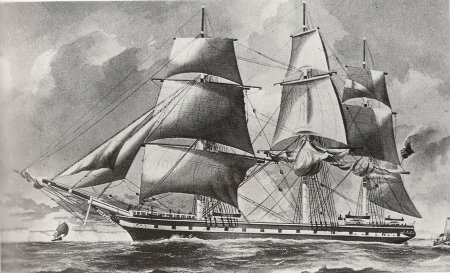
This article continues the story of Thomas and Elizabeth Jerrems, who eloped in such a dramatic fashion in 1837. In my previous article about their elopement I concluded with the death of my great great grandfather Thomas in 1867 and promised to tell you about his widow Elizabeth and some of their lesser-known children (I have already written about some of the better known children).
I cannot hope to repeat the high drama of the elopement, however I believe that you will find the following account to be interesting.
Readers will see that the family of ten children (with a preponderance of boys, numbering seven) gradually dispersed, leaving only half the family with their mother in Melbourne. She would never see three of the children again.
To put this into context, the simplest way of starting is to list all of their children in chronological order, with a summary of each child. I will then tell you about the lesser known children Thomas Jnr, George Jepson and Catherine.
| The Children |
The children were:
- Thomas Cane/Cain (“Thomas Jnr”).Stayed in Melbourne after a sojourn in Sydney, moved later to South Australia (see later)
- Elizabeth Sophia. Returned to England (I will write about this in a later article)
- Frances Jane. Possibly returned to England (I will write about this in a later article)
- William George. Moved from Melbourne to Sydney, then the United States (numerous JJs).
- George Jepson. Stayed in Australia (see later)
- Edwin Lewis. Moved from Melbourne to South Australia (see JJ of January 2012
- Charles. Moved from Melbourne to Sydney (see JJ of July 2006)
- Robert Cane. Stayed in Melbourne (see JJ of February 2010)
- Catherine. Stayed in Melbourne (see later)
- Arthur. Stayed in Melbourne (article drafted but not published)
| Thomas Jnr |
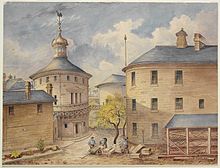
It would be safe to assume that Thomas Jnr (born in 1838) assisted his father in the early days in Melbourne before the rest of the family arrived there. However my first record of Thomas relates to a donation (recorded in the Sydney Morning Herald in August 1866, three months before the death of his father in Melbourne) by T.C.Jerrems of ten shillings to the Wrecks Relief Fund. This donation was collected at the Illustrated Sydney News Printing Office, Sydney, where he possibly worked.
The ten shillings donated by Thomas was a large sum in those days, possibly the current day equivalent of about $200. Hoping to locate a significant shipwreck at the time which may have led to such generosity, comparable to the 1857 loss of the “Dunbar” and 121 people (see photo), I discovered that in the 1860s there were a staggering 225 shipwrecks on the NSW coast, surpassed only by 237 in the 1870s. This made it impossible to deduce what wreck might have provoked his beneficence, but it occurs to me that perhaps he himself had been involved in a shipwreck while travelling between Melbourne and Sydney, and his donation was to show his gratitude at being saved.
The Sands Directories list him at 98 Market Street (with no occupation shown) in 1868, and at 305 George St with a “Photographic Goods Depot” in 1870 and 1871.
The George Street address is supported by a SMH advertisement in February 1869 for “a smart industrious LAD, to make himself useful about a photographic gallery”. In nearby Pitt Street someone needed “a good second hand dog cart, cheap”, giving an insight as to a common method of transport.
Thomas was resourceful, advertising in April 1870 that he had “a splendid assortment of Messrs Graves’s celebrated Engravings”, followed the next month by an ad for “Portraits of English Champion Runners and other celebrities” for one shilling each.
Henry Graves (1806-1892) was a prominent printseller and publisher in Victorian London. He published many of the artists whose works were exhibited at the Royal Academy and National Portrait Gallery, publishing reproductive engravings and compiling catalogues.
Obviously Thomas had an eye to quality in selecting the Graves engravings.However it is likely that he decided to move on during the following year because in an advertisement in May 1872 he proposed to let “a photographic goods warehouse” because “the proprietor was leaving Sydney”.
A collection of references to premises for letting in Auckland (in New Zealand) and Rockhampton (in Queensland, Australia) during this period indicates that he had visited those towns and may have opened (or at least planned to open) shops there.
It seems that Thomas then moved back to Carlton in Melbourne. This was close to Richmond, where his mother and some siblings were concentrated. He kept a low profile (not being listed in any trade or postal directories) until he was accepted as a member of the South Australian Photographic Society in Adelaide in January 1893. Four months later, at the age of 55 (definitely a “late starter”!) he married a widow, Mary Jane Martin, in Adelaide.
In 1899 Thomas had returned to Melbourne, being listed in a directory as running a grocery and confectionery shop at 360 Rathdown Street, North Carlton.
Subsequently he opened a shop opposite the Town Hall (see photo) at Norwood (a suburb of Adelaide) in South Australia and died at the age of about 66 in Adelaide Hospital in September 1904. In 1909 his widow remarried, to Frederick Richard Steed.
| Catherine |

Comparison of Elizabeth and daughter Catherine’s postal addresses indicates that Catherine (born in 1850) was Elizabeth’s lifetime companion, which must have been a great comfort to Elizabeth.
As Elizabeth’s only daughter left in Australia, and Elizabeth having seven sons, perhaps in those days there was a certain expectation that Catherine would look after her mother.
In the elopement article Elizabeth (her mother) was described as “a young lady of great personal charms”. My Aunty Vi admired Catherine (“Aunt Kate”), describing her eloquently as a “lady”, indicating that Catherine had followed in her mother’s shoes.
With regular employment as a housekeeper (a very responsible position in a large household), Catherine would have been able to assist her mother financially. Catherine (probably like her mother) was quite accomplished. She appears to have done a teaching course, and after her mother’s death she was heavily involved in charitable work, particularly the Melbourne Benevolent Asylum (see photo of the Asylum).
At an age when many women would have decided to observe life from the safety of their rocking chair she was a generous donor to the Asylum, and was a member of the Asylum Committee for a number of years in her 60s and 70s after it was relocated to Cheltenham. It was renamed “The Kingston centre” in 1970. At one stage she organised the knitting of leg warmers for inmates, a very practical contribution in a city which has cold winters.
The huge Asylum was one of many established throughout the colonies of Australia in the 19th century to house deserted and destitute men, women and children not able to support themselves.
Catherine was also a keen member of the Dickens Fellowship Literary Society (on one occasion at the age of 74 delivering a paper about Dickens) and was elected to its Committee in 1927. She took part in church affairs, being a Melbourne delegate to the 1916 Church of Christ National Annual Conference in Adelaide.
Finally, periodically Catherine travelled by train to Sydney to visit her Sydney relatives, a very long trip for an elderly lady.
When this grand old lady died at Prahran (Melbourne) in 1930 at the age of 80 her death notice rather touchingly described her as “loved sister of Arthur R. Jerrems”, Arthur being her youngest brother by two years. She had outlived all her other siblings, including my great grandfather Charles who had died three years earlier.
| George Jepson Jerrems |
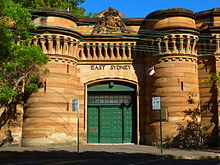
George Jepson Jerrems (born in 1844) was obviously named after his illustrious grandfather, surgeon George Jepson. However it would be fair to say that he did not inherit his grandfather’s illustriousness.
For years George was a mystery to me because I could not find any references to him coming out to Australia or living in Australia. I assumed he had died during childhood. However this situation changed when the National Library of Australia began digitising old newspapers. At least I have now established a few facts about him, starting with my first brief record of him sailing from Sydney to Melbourne in 1868.
But before going further I would like to say that I have found parallels between the family of Nicoll the Tailor and the family of Thomas and Elizabeth. The most obvious parallels are that both families lived in Melbourne for a while in the 1850s and 1860s and then dispersed to all points of the compass. However, less obviously, both families had a “black sheep” who disappeared later off my radar screen. In the case of Nicoll the Tailor the black sheep was Alexander Jnr, who was jailed for drunkenness and later charged with embezzling from his brother in 1871. By complete coincidence George Jepson was charged with embezzlement also, in the same year.
This unfortunate state of affairs arose in Sydney, when (according to the NSW Police Gazette) George was charged in Sydney in March 1871 (at the age of 27) with embezzling ten shillings and sixpence from the grandiosely named American and Australian Photographic Company. The next month he pleaded guilty to the charge. The judge obviously considered the offence to be more than a mere peccadillo because he threw the proverbial book at my hapless great great uncle and sentenced him to six months hard labour at Sydney’s notorious Darlinghurst Gaol (see photos of the Gaol). By modern day standards this sentence seems to be inordinately severe, for stealing the modern day equivalent of $200.
Australian poet Henry Lawson spent time incarcerated in this gaol during some of the turbulent years of his life and described the gaol as “Starvinghurst Gaol” due to the meagre rations given to the inmates.
Although the architectural merit of the gaol would have been completely lost on its inmates (including the hapless George and the 76 people hanged there), the main material used for construction of the gaol is Sydney sandstone, cut into large blocks by convicts. A tall circular chapel stands in the middle of the site, around which are sited the six rectangular cellblocks in a radial fashion.
The jail was later vacated, and in 1922 the Art Department of the Sydney Technical College was transferred there. This became the campus of the East Sydney Technical College. By coincidence my grandfather (the stretcher bearer referred to in the JJ of February 2009) taught at the Art School for many years after he had recovered sufficiently from shell shock to re-enter the work force.
I would imagine that George would have had a sinking feeling in the pit of his stomach as he heard the huge green doors of the gaol’s entrance clang shut behind him upon his arrival.
In another coincidence, the company whose money George had misappropriated was owned by the famous Beaufoy Merlin, who I wrote about in the Jerrems Journal of August 2011. Merlin had photographed many buildings in Melbourne and on his travels north to Sydney, where he arrived in September 1870. In Sydney he photographed a large number of buildings and later went out to the goldfields under commission from Bernard Holterman. If George had played his cards better perhaps he could have had an interesting career in photography.
Bearing in mind that embezzler mostly embezzled money from their employers, it is very likely that George was working for Merlin for some months before his activities were detected.
It is also possible that George had gained previous experience in photography by working for his brother Thomas in Sydney, this experience enabling him to obtain work with Merlin.
Although the lack of later adverse references in the Press to George might indicate that he stayed out of trouble, the lack of reference to him in trade and postal directories and electoral records also indicates that he probably led an itinerant existence, not marrying or settling down.
The next (and last) references to George came a whole 20 years later. They were classified advertisements in “The Queenslander” (a Brisbane newspaper) of 11th October 1890 with his mother’s poignant appeal:
GEORGE JEPSON JERREMS,-Anxious to hear from you. Any information concerning him thankfully received by his Mother, Lennox-street, Richmond, Victoria.
The fact that the ad was only published once could indicate that Elizabeth expected to receive a reply from her 46 year old son. When a reply was not forthcoming, three months later this ad was followed by three consecutive ads in the same paper in January and February 1891:
GEORGE JEPSON JERREMS. Your friends are anxious to hear from you. Anyone knowing his whereabouts, please communicate with his mother, MRS JERREMS, 148 Lennox St. Richmond, Melbourne.
I feel a pang of sadness every time I read these ads. Fellow readers will no doubt sense my great great grandmother’s anguish for her prodigal son. Perhaps the ads carried a connotation of “come home, all is forgiven”.
The aspect that these ads only appeared in a Queensland newspaper (and not in his home State of Victoria or the adjacent States of South Australia and New South Wales) could indicate that Elizabeth had information that he was living in Queensland. For instance perhaps he had written to her at some stage.
At the time of the later ads the Queensland rural economy had been thrown into disarray by the famous 1891 Great Shearers Strike, and all economies had already been hit by the start of the 1890s Depression, second only to the 1930s Great Depression. These events may have induced our hero to return home in due course.
| Elizabeth is reunited with Thomas Snr |
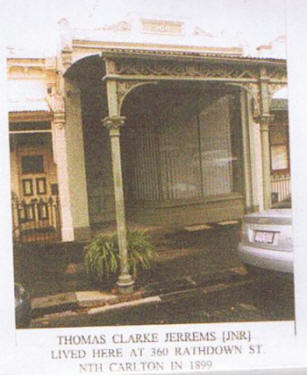
Finally Elizabeth and Catherine lived with Arthur and his family in Richmond in a cottage at 201 Lennox Street (now a block of home units) until Elizabeth’s death at the advanced age of 86.
Sadly, our last record of Elizabeth is her brief death notice in the Argus of Monday 16th June 1902:
THE friends of the late Mrs ELIZABETH JERREMS are respectfully invited to follow her remains to the place of interment, Melbourne General Cemetery.
The funeral to move from her late residence, No. 201 Lennox street Richmond on Tuesday the 17th inst at 2 o’clock pm.
HERBERT KING, Undertaker, Lennox street, Richmond.
| Elizabeth looks back |
As Elizabeth reached her eighties and looked back at her life, I wonder what would have run through her mind, harking back to those heady days when she and Thomas eloped in such dramatic style in 1837 and no doubt felt that the world was at their feet.
With the benefit of hindsight, bearing in mind particularly that she and Thomas lived together for no more than 20 years of her 86 year life, and that she had survived him by 46 years, I wonder what her answer would have been to that time honoured question of “would you do it all again?”.
I wonder. What do you think?

